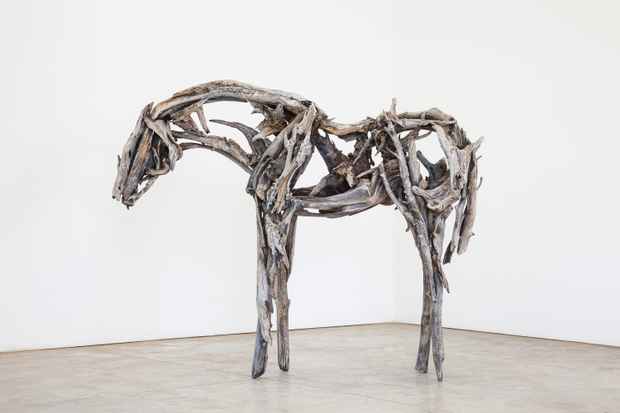Deborah Butterfield “New Sculpture”
Danese Corey

This event has ended.
There is an emotional and perceptual clarity and balance to Deborah Butterfield’s sculpture, which emerges from a lifelong, single-minded concentration on the horse as subject matter. In her current exhibition, Butterfield continues to demonstrate her uncanny ability to observe and capture the equine spirit. Beyond its keenly depicted realism there lies a profound relationship between artist and animal. A work by Butterfield strikes us in both look and gesture as absolutely true to our notions of a horse and becomes something fresh and powerful, as well as tender and vulnerable.
Butterfield rejects the role of the horse as a mere prop in a human narrative. In terms of art history, she shares more with Chinese art, particularly as it began to coalesce in the Tang dynasty (A.D. 618-907) than with Western art. Unlike the West’s recurring representation of the horse as a subservient creature, as a pedestal for humans and as a tool of war, the Tang extolled the horse as a free, proud, and noble creature.
Deborah Butterfield first created sculpture in the form of a horse in the 1970’s using mud, clay and sticks. In 1977, she moved to a ranch in Montana and in 1979 began using scrap metal and found steel to create her work. For more than two decades, while continuing to use found metal, she began utilizing bronze, casting her sculptures from “stray, downed pieces of wood.” Butterfield carefully, intuitively, selects the branches and sticks which are used to “draw” her horses. The lines of the branches do not simply outline the forms of horses, they create contours through an accumulation of simple or energetic lines that seem to build up from within. This is three-dimensional gesture drawing, and the result is both skeletal and muscular. Like a good drawing, they convey movement, weight, energy and volume. These models or “ghosts” (as the artist refers to them) are then cast, burning the wood away with molten bronze, creating one, unique sculpture to which she then methodically, expertly applies her patina.
Butterfield’s work stands as a consummate portrayal of the world’s most durable, most mystical, most consistently recorded animal. From the prehistoric caves of Altamira and Lascaux, through ancient Chinese art, the Renaissance, and centuries of English and French artists (Stubbs and Muybridge, Gericault and Delacroix, Degas and Lautrec), Butterfield, along with Frederic Remington and Charles Russell, is one of few Americans to successfully interpret the horse ethos. Distinct from these other artists, however, is the sheer monumental scale of her sculpture. Larger than life-sized, the sculptures project imposing physical presence and emotional content communicated through gesture and stance. They are contemplative, self-contained creatures, like equine versions of the isolated, expressive humans sculpted by Giacometti.
Media
Schedule
from September 12, 2014 to October 11, 2014
Opening Reception on 2014-09-11 from 18:00 to 20:00